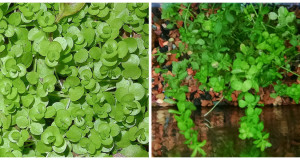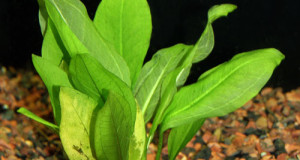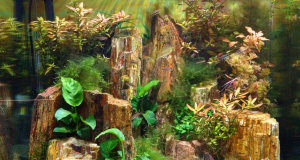Hello, Frank Indiviglio here.
Please see Part I of this article for information concerning typical brackish water plants and algae.
A number of well-known freshwater aquarium plants adjust quite nicely to brackish water. Given the great variety of species that are available, I’m sure many others will be found.
Experimenting With Freshwater Plants
 If you are of a mind to experiment, first research various natural habitats, keeping an eye out for plants that thrive along coastlines, estuaries and in other such situations….these might be exposed to salt water during floods or at high tide. In general, freshwater plants with waxy leaf and stem coverings make the best prospects with which to begin.
If you are of a mind to experiment, first research various natural habitats, keeping an eye out for plants that thrive along coastlines, estuaries and in other such situations….these might be exposed to salt water during floods or at high tide. In general, freshwater plants with waxy leaf and stem coverings make the best prospects with which to begin.
Bear in mind that the change from fresh to brackish water is an extreme one, and can easily shock your plants. Treat them as you would a new, delicate fish and increase their exposure to brackish water gradually. For untested species, you might consider dripping brackish water into the plant’s tank via a section of airline tubing during the acclimatization period.
 Much favored by freshwater aquarists and a standby for grammar school science experiments, Anachris is very hardy and highly recommended for use in brackish tanks. Most agree that it is the most likely of all freshwater plants to thrive in this foreign environment.
Much favored by freshwater aquarists and a standby for grammar school science experiments, Anachris is very hardy and highly recommended for use in brackish tanks. Most agree that it is the most likely of all freshwater plants to thrive in this foreign environment.
Anachris grows well as a rooted or floating plant and, in strong light, can add an inch or more a day to its length. Cuttings taken anywhere along the stem will grow into new plants.
Temple Plant, Hygrophila corymbosa
This most attractive of aquarium plants does very well in brackish water, but is considered a delicacy by snails, hermit crabs and many fishes. It and related species, which are native to South and Southeast Asia, can be propagated from cuttings and grow best under bright lights.
Cabomba aquatica
Another popular freshwater plant, this South American native has delicate leaves which cannot withstand the attentions of herbivorous fishes and invertebrates. However, when housed with halfbeaks, mudskippers and others that will not molest it, Cabomba makes a fine addition to the brackish aquarium.
Aquatic Grasses – Sagittaria and Vallisneria
Sagittaria, relatively impervious to salt water damage and unpalatable to most organisms, is one of the best freshwater plants to use in brackish systems. The widely-available grass Vallisneria does very well also, even under subdued lighting, but is considered a tasty food by many aquatic animals.
Hornwort, Ceratophyllum demersum
Reaching 10 feet or more in length in the wild and equally at home in cold and warm water, this hardy survivor is an excellent candidate for brackish water tanks. It can get by in dimly-lit aquariums, but in such situations its foliage will pale considerably.
Water Sprite, Ceratopteris thalicroide
 Even in such an unnatural environment as brackish water, this plant will grow quite vigorously if kept warm and under bright lights. It can be maintained either floating or rooted, and in different situations will develop rounded, bulky or fern-like leaves. Water sprite’s prodigious rate of growth often compensates for the attentions of plant-eaters.
Even in such an unnatural environment as brackish water, this plant will grow quite vigorously if kept warm and under bright lights. It can be maintained either floating or rooted, and in different situations will develop rounded, bulky or fern-like leaves. Water sprite’s prodigious rate of growth often compensates for the attentions of plant-eaters.
Chain Swordplant, Echinodorus tenellus
This attractive plant spreads rapidly via runners (hence the “chain” portion of its name) and is fully grown at 4 inches in height. As is true for its larger relatives, the chain sword requires warm water and a well-lit environment.
Further Reading
Anachris (Egeria) densa is widely introduced in the USA and elsewhere. The University of California has posted an interesting account of its natural and unnatural history at http://ucce.ucdavis.edu/datastore/detailreport.cfm?surveynumber=182&usernumber=43.
Please write in with your questions or to relate your own experiments with aquatic plants. Thanks, until next time, Frank Indiviglio.
 That Fish Blog – Aquarium Advice and Information
That Fish Blog – Aquarium Advice and Information




Hi, would fiddler crabs eat any of these plants? Is there any easy way to take pH and other tests,,,I have a complex kit, but would like to know if the strips I saw advertised on your site are reliable if I am keeping mudskippers and crabs? Thanks.
Hello, Frank Indiviglio here. Thanks for your interest in our blog.
The strip-type test kits are quite accurate, and would be fine to use in a tank housing fiddler crabs. Fiddler crabs, mudskippers and other brackish water animals (many puffers, archerfish, bumblebee gobies, etc.) live in salt marshes, estuaries and other habitats that are subject to daily fluctuations in salinity, pH and other water parameters. Care still needs to be taken as regards water quality, but color-comparison strip tests are sufficient for testing. The Mardel Master Test Kit should have everything you need.
Fiddler crabs do not eat live plants, although they will pick algae from the leaves and consume decaying vegetation. Fiddlers will do well on a diet composed of flake foods, freeze dried plankton and other freeze dried foods and algae tablets. A bit of shrimp or a tiny piece of fish can be offered from time to time as well. They prefer to feed on land, but many species will also eat while submerged.
Best regards, Frank Indiviglio.
I’ve also heard that tiger lotus(nymphaea lotus) do well in brackish water. Can you confirm this?
Hi Michael, I have read some accounts that tiger lotus can be grown in brackish conditions, but none with alot of detail as far as how the plants performed or how long they lasted. Though I have no first hand experience in doing so, I have my doubts. There are some species of Nymphaea, sush as a Spatterdock and cow lily that have thicker waxier leaves and stems that maycan tolerate low concentrations of salt, but do not thrive in higher concentrations. Tiger lotus is much more delicate in build, and it is not native to estuaries where it would be exposed to brackish conditions. I would speculate that it would not fare well in pure brackish conditions for long. Perhaps with very slow acclimation to more saline conditions the plants may adapt somewhat, and if you have your heart set on lotus (one of my favorites) for your aqaurium it wouldn’t hurt to try. The bulbs are rather inexpensive, may end up worth the investment to try. If you do, I’d love to know how it goes for you and what your methods were!